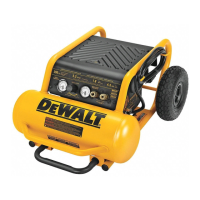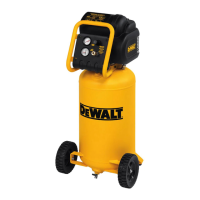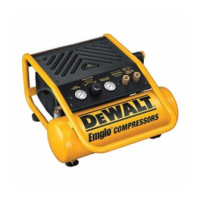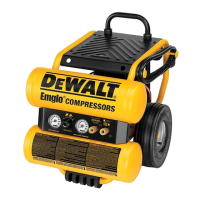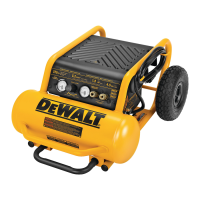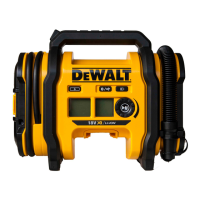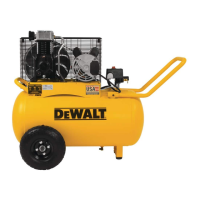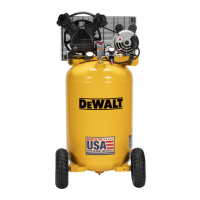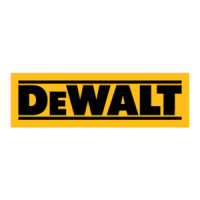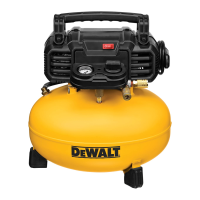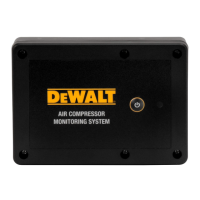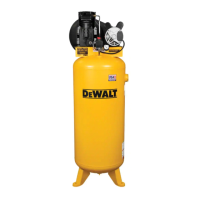INSTRUCTION MANUAL
GUIDE D'UTILISATION
MANUAL DE INSTRUCCIONES
D55146
Oil Free Portable Air Compressor
Compresseur d’air portatif sans huile
Compresor de aire sin aceite portátil
INSTRUCTIVO DE OPERACIÓN, CENTROS DE SERVICIO
Y PÓLIZA DE GARANTÍA. ADVERTENCIA: LÉASE ESTE
INSTRUCTIVO ANTES DE USAR EL PRODUCTO.
DeWALT Industrial Tool Co., 701 East Joppa Road, Baltimore, MD 21286
(AUG18) Part No. N618182 D55146 Copyright © 2007, 2008, 2009, 2010, 2016, 2017, 2018 D
eWALT
The following are trademarks for one or more DeWALT power tools: the yellow and black color scheme; the “D”
shaped air intake grill; the array of pyramids on the handgrip; the kit box configuration; and the array of lozenge-
shaped humps on the surface of thetool.
If you have questions or comments, contactus.
Pour toute question ou tout commentaire, nouscontacter.
Si tiene dudas o comentarios,contáctenos.
1-800-4-DeWALT • www.dewalt.com
Definitions: Safety Guidelines
The definitions below describe the level of severity for each signal word. Please read the
manual and pay attention to thesesymbols.
DANGER: Indicates an imminently hazardous situation which, if not avoided, will
result in death or seriousinjury.
WARNING: Indicates a potentially hazardous situation which, if not avoided, could
result in death or seriousinjury.
CAUTION: Indicates a potentially hazardous situation which, if not avoided, may
result in minor or moderateinjury.
NOTICE: Indicates a practice not related to personal injury which, if not avoided, may
result in property damage.
IF YOU HAVE ANY QUESTIONS OR COMMENTS ABOUT THIS OR ANY D
e
WALT TOOL,
CALL US TOLL FREE AT: 1-800-4-D
e
WALT (1-800-433-9258)
Important Safety Instructions
WARNING: Do not operate this unit until you read this instruction manual for safety,
operation and maintenanceinstructions.
WARNING: This product contains chemicals known to the State of California to cause
cancer, and birth defects or other reproductive harm. Wash hands afterhandling.
WARNING: Some dust contains chemicals known to the State of California to cause cancer,
birth defects or other reproductive harm such as asbestos and lead in lead basedpaint.
SAVE THESE INSTRUCTION
DANGER: RISK OF EXPLOSION OR FIRE
WHAT CAN HAPPEN HOW TO PREVENT IT
• It is normal for electrical contacts
within the motor and pressure switch
tospark.
• Always operate the compressor in a well
ventilated area free of combustible materials,
gasoline, or solventvapors.
• If electrical sparks from compressor
come into contact with flammable
vapors, they may ignite, causing fire
orexplosion.
• If spraying flammable materials, locate
compressor at least 20' (6.1 m) away from
spray area. An additional length of hose may
berequired.
• Store flammable materials in a secure
location away fromcompressor.
• Restricting any of the compressor
ventilation openings will cause serious
overheating and could causefire.
• Never place objects against or on top of
compressorpump.
• Operate compressor in an open area at
least 12" (30.5 cm) away from any wall or
obstruction that would restrict the flow of
fresh air to the ventilationopenings.
• Operate compressor in a clean, dry well
ventilated area. Do not operate unit indoors
or in any confinedarea.
• Unattended operation of this product
could result in personal injury or
property damage. To reduce the risk
of fire, do not allow the compressor to
operateunattended.
• Always remain in attendance with the
product when it isoperating.
• Always turn off and unplug unit when not
inuse.
DANGER: RISK TO BREATHING (ASPHYXIATION)
WHAT CAN HAPPEN HOW TO PREVENT IT
• The compressed air directly from your
compressor is not safe for breathing.
The air stream may contain carbon
monoxide, toxic vapors, or solid
particles from the air tank. Breathing
these contaminants can cause serious
injury ordeath.
• Never use air obtained directly from the
compressor to supply air for human
consumption. The compressor is not
equipped with suitable filters and in-line safety
equipment for human consumption.
• Exposure to chemicals in dust created
by power sanding, sawing, grinding,
drilling, and other construction activities
may beharmful.
• Sprayed materials such as paint, paint
solvents, paint remover, insecticides,
weed killers, may contain harmful
vapors andpoisons.
• Work in an area with good cross ventilation.
Read and follow the safety instructions
provided on the label or safety data sheets
for the materials you are spraying. Always
use certified safety equipment: NIOSH/
OSHA respiratory protection or properly fit-
ting face mask designed for use with your
specificapplication.
WARNING: RISK OF BURSTING
Air Tank: On February 26, 2002, the U.S. Consumer Product Safety Commission published
Release # 02-108 concerning air compressor tank safety:
Air compressor receiver tanks do not have an infinite life. Tank life is dependent upon
several factors, some of which include operating conditions, ambient conditions, proper
installations, field modifications, and the level of maintenance. The exact effect of these
factors on air receiver life is difficult topredict.
If proper maintenance procedures are not followed, internal corrosion to the inner wall of the
air receiver tank can cause the air tank to unexpectedly rupture allowing pressurized air to
suddenly and forcefully escape, posing risk of injury toconsumers.
Your compressor air tank must be removed from service by the end of the year shown on
your tank warninglabel.
The following conditions could lead to a weakening of the air tank, and result in a violent air
tank explosion:
WHAT CAN HAPPEN HOW TO PREVENT IT
• Failure to properly drain condensed
water from air tank, causing rust and
thinning of the steel airtank.
• Drain air tank daily or after each use. If air tank
develops a leak, replace it immediately with a
new air tank or replace the entirecompressor.
• Modifications or attempted repairs to the
airtank.
• Never drill into, weld, or make any modifications
to the air tank or its attachments. Never
attempt to repair a damaged or leaking air
tank. Replace with a new airtank.
• Unauthorized modifications to the safety
valve or any other components which
control air tankpressure.
• The air tank is designed to withstand specific
operating pressures. Never make adjustments
or parts substitutions to alter the factory set
operatingpressures.
Attachments & accessories:
• Exceeding the pressure rating of air tools,
spray guns, air operated accessories,
tires, and other inflatables can cause
them to explode or fly apart, and could
result in seriousinjury.
• Follow the equipment manufacturers
recommendation and never exceed the
maximum allowable pressure rating of
attachments. Never use compressor to
inflate small low pressure objects such as
children’s toys, footballs, basketballs,etc.
Tires:
• Over inflation of tires could result in
serious injury and property damage.
• Use a tire pressure gauge to check the tires
pressure before each use and while inflating
tires; see the tire sidewall for the correct tire
pressure.
NOTE: Air tanks, compressors and similar
equipment used to inflate tires can fill small
tires very rapidly. Adjust pressure regulator
on air supply to no more than the rating of
the tire pressure. Add air in small increments
and frequently use the tire gauge to prevent
overinflation.
WARNING: RISK OF ELECTRICAL SHOCK
WHAT CAN HAPPEN HOW TO PREVENT IT
• Your air compressor is powered by
electricity. Like any other electrically
powered device, If it is not used properly
it may cause electricshock.
• Never operate the compressor outdoors when
it is raining or in wetconditions.
• Never operate compressor with protective
covers removed ordamaged.
• Repairs attempted by unqualified
personnel can result in serious injury or
death byelectrocution.
• Any electrical wiring or repairs required on this
product should be performed by a D
eWALT
factory service center or a D
eWALT authorized
service center in accordance with national
and local electricalcodes.
• Electrical Grounding: Failure to provide
adequate grounding to this product
could result in serious injury or death
from electrocution. See Grounding
Instructions underInstallation.
• Make certain that the electrical circuit to
which the compressor is connected provides
proper electrical grounding, correct voltage
and adequate fuseprotection.
WARNING: RISK FROM FLYING OBJECTS
WHAT CAN HAPPEN HOW TO PREVENT IT
• The compressed air stream can cause
soft tissue damage to exposed skin and
can propel dirt, chips, loose particles,
and small objects at high speed, resulting
in property damage or personalinjury.
• Always wear certified safety equipment: ANSI
Z87.1 eye protection (CAN/CSA Z94.3) with
side shields when using thecompressor.
• Never point any nozzle or sprayer toward any
part of the body or at other people oranimals.
• Always turn the compressor off and bleed
pressure from the air hose and air tank before
attempting maintenance, attaching tools
oraccessories.
WARNING: RISK OF HOT SURFACES
WHAT CAN HAPPEN HOW TO PREVENT IT
• Touching exposed metal such as the
compressor head, engine head, engine
exhaust or outlet tubes, can result in
seriousburns.
• Never touch any exposed metal parts on
compressor during or immediately after
operation. Compressor will remain hot for
several minutes afteroperation.
• Do not reach around protective shrouds or
attempt maintenance until unit has been
allowed tocool.
WARNING: RISK FROM MOVING PARTS
WHAT CAN HAPPEN HOW TO PREVENT IT
• Moving parts such as the pulley,
flywheel, and belt can cause serious
injury if they come into contact with you
or yourclothing.
• Never operate the compressor with guards or
covers which are damaged orremoved.
• Keep your hair, clothing, and gloves away
from moving parts. Loose clothes, jewelry, or
long hair can be caught in moving parts.
• Air vents may cover moving parts and should
be avoided as well.
• Attempting to operate compressor
with damaged or missing parts or
attempting to repair compressor with
protective shrouds removed can expose
you to moving parts and can result in
seriousinjury.
• Any repairs required on this product should
be performed by a D
eWALT factory service
center or a D
eWALT authorized servicecenter.
WARNING: RISK OF UNSAFE OPERATION
WHAT CAN HAPPEN HOW TO PREVENT IT
• Unsafe op er a tion of your air compressor
could lead to se ri ous in ju ry or death to
you orothers.
• Review and understand all instructions and
warnings in thismanual.
• Be come fa mil iar with the op eration and con-
trols of the aircompressor.
• Keep operating area clear of all persons,
pets, andobstacles.
• Keep chil dren away from the air compressor
at alltimes.
• Do not operate the product when fatigued or
under the influence of alcohol or drugs. Stay
alert at alltimes.
• Never defeat the safety fea tures of thisprod-
uct.
• Equip area of operation with a
fireextinguisher.
• Do not op er ate machine with missing,
broken, or un au tho rizedparts.
• Never stand on thecompressor.
WARNING: RISK OF FALLING
WHAT CAN HAPPEN HOW TO PREVENT IT
• A portable compressor can fall from
a table, workbench, or roof causing
damage to the compressor and could
result in serious injury or death to
theoperator.
• Always operate compressor in a stable secure
position to prevent accidental movement of
the unit. Never operate compressor on a roof
or other elevated position. Use additional air
hose to reach highlocations.
WARNING: RISK OF
INJURY FROM LIFTING
WHAT CAN HAPPEN HOW TO PREVENT IT
• Serious injury can result from attempting
to lift too heavy anobject.
• The compressor is too heavy to be lifted by
one person. Obtain assistance from others
beforelifting.
WARNING: RISK FROM NOISE
WHAT CAN HAPPEN HOW TO PREVENT IT
• Under some conditions and duration
of use, noise from this product may
contribute to hearing loss.
• Always wear proper hearing protection
duringuse.
SAVE THESE INSTRUCTIONS
FOR FUTURE USE
Components (Fig. 1)
A. Sliding Handles H. Drain Valve
B. Handle Grip I. Cord Wrap
C. Storage Support J. Air Filter
D. Regulated Pressure Gauge K. Tank Pressure Gauge
E. Quick Connects L. Mini-Switch
F. Regulator G. Safety Valve
FEATURES (FIG. 1)
MINI-SWITCH
Place this switch (L) in the ON ( I ) position to start the unit and OFF ( 0 ) to remove power
at the end of each use.
PRESSURE SWITCH
The pressure switch automatically starts the motor when the air tank pressure drops below
the factory set cut-in pressure. It stops the motor when the air tank pressure reaches the
factory set cut-outpressure.
SAFETY VALVE
If the pressure switch does not shut off the air compressor at its cut-out pressure setting,
the safety valve (G) will protect against high pressure by popping out at its factory set
pressure (slightly higher than the pressure switch cut-outsetting).
CHECK VALVE
When the air compressor is operating, the check valve is open, allowing compressed air
to enter the air tank. When the air compressor reaches cut-out pressure, the check valve
closes, allowing air pressure to remain inside the airtank.
TANK PRESSURE GAUGE
The tank pressure gauge (K) indicates the reserve air pressure in the tank.
REGULATED PRESSURE GAUGE
The regulated pressure gauge (D) indicates the air pressure available at the outlet side of
the regulator. This pressure is controlled by the regulator.
REGULATOR
The regulator (F) controls the air pressure shown on the regulated pressure gauge. Pull the
knob out and turn clockwise to increase pressure and counterclockwise to decrease pressure.
When the desired pressure is reached push knob in to lock in place. The regulated pressure
range is 7–150psi.
WARNING: Risk of Bursting. Too much air pressure causes a hazardous risk of bursting.
Check the manufacturer’s maximum pressure rating for air tools and accessories. The
regulator outlet pressure must never exceed the maximum pressurerating.
UNIVERSAL QUICK CONNECT BODIES
The universal quick connect body (E) accepts the three most popular styles of quick connect
plugs: Industrial, automotive, and ARO. One hand push-to-connect operation makes
connections simple and easy. The two quick connect bodies allow the use of two tools at
the sametime.
DRAIN VALVE
The drain valve (H) is located at the base of the air tank and is used to drain condensation
at the end of each use.
See Draining Air Tank under Maintenance.
COOLING SYSTEM
This compressor contains an advanced design cooling system. It is normal for this fan to
blow air through the vent holes in large amounts. The cooling system is working when air
isexpelled.
AIR COMPRESSOR PUMP
The pump compresses air into the air tank. Working air is not available until the compressor
has raised the air tank pressure above that required at the airoutlet.
AIR INTAKE FILTER
The filter (J) is designed to clean air entering the pump. To ensure the pump continually receives
